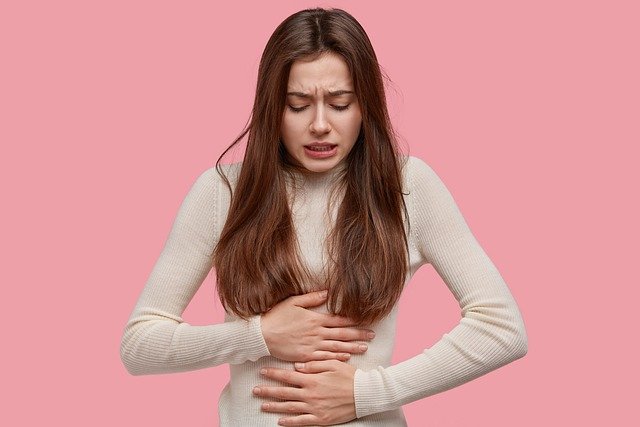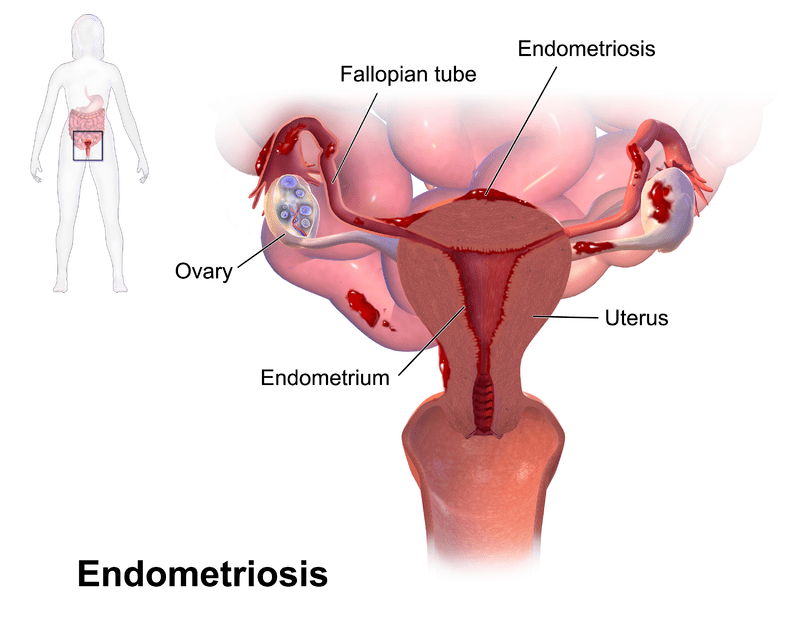What is the Difference Between Dysmenorrhea and Endometriosis
Table of Contents
The key difference between dysmenorrhea and endometriosis is that dysmenorrhea is a medical condition that causes severe and frequent cramps and pains during periods, while endometriosis is a medical condition that causes the growing of tissue similar to the tissue that normally lines inside of the uterus (endometrium) outside the uterus, in places like ovaries and fallopian tubes.
Menstruation occurs when the uterus sheds its lining once a month. Some pain, discomfort, and cramps are normal in the menstruation period. However, excessive pain might be due to underlying medical conditions such as dysmenorrhea, endometriosis, premenstrual syndrome (PMS), fibroids in the uterus, pelvic inflammatory disease, adenomyosis, and cervical stenosis.
CONTENTS
1. Overview and Key Difference
2. What is Dysmenorrhea
3. What is Endometriosis
4. Similarities – Dysmenorrhea and Endometriosis
5. Dysmenorrhea vs Endometriosis in Tabular Form
6. Summary – Dysmenorrhea vs Endometriosis
What is Dysmenorrhea?
Dysmenorrhea is a medical condition that causes severe and frequent cramps and pains during periods. There are two types of dysmenorrhea as primary and secondary. Primary dysmenorrhea occurs when a woman first starts her period, and it continues throughout her life. It is also usually lifelong. Primary dysmenorrhea may cause severe and frequent menstrual cramping from severe and abnormal uterine contractions. Secondary dysmenorrhea is due to some physical reasons, and it normally starts later in life.

Figure 01: Dysmenorrhea
The cause of primary dysmenorrhea is the abnormal contraction of the uterus due to chemical (prostaglandins) imbalance. The cause of secondary dysmenorrhea is other medical conditions like pelvic inflammatory disease, endometriosis, uterine fibroids, abnormal pregnancy, infections, tumors, or polyps in the pelvic cavity. The symptoms of this condition include cramping in the lower abdomen, pain in the lower abdomen, low back pain, nausea, vomiting, diarrhea, fatigue, weakness, fainting, and frequent headaches. Women who smoke or drink, women who are overweight or started their period before age 11, or those who never get pregnant are usually at risk of developing this condition. Dysmenorrhea can be diagnosed through ultrasound, MRI, laparoscopy, and hysteroscopy. The treatments for dysmenorrhea include prostaglandins inhibitors, oral contraceptives, progesterone hormone treatment, giving acetaminophen, diet changes, regular exercises, using a heating pad across the abdomen, hot bath, abdominal massage, endometrial ablation, endometrial resections, and hysterectomy.
What is Endometriosis?
Endometriosis is a medical condition where tissue similar to the lining of the uterus (endometrium) starts to grow in other places in the reproductive system, such as the ovaries and fallopian tubes. It can affect women at any age. Typically, it is a long-term condition that can have a significant impact on well being of women. The symptoms of this condition include pain in the lower tummy or back, period pain, pain during or after sex, pain while peeing during periods, feeling sick, diarrhea, blood in the pee during periods, and difficulty getting pregnant.

Figure 02: Endometriosis
The risk factors for endometriosis include a family history of endometriosis, early age of the first occurrence of the menstruation, short menstrual cycle, long duration of menstrual flow, heavy bleeding during menses, inverse relationship to parity, defects in the uterus, and delayed childbearing. Moreover, this condition can be diagnosed through pelvic exams, ultrasound, MRI, and laparoscopy. Endometriosis can be treated with pain medications (NSAIDs), hormone therapy, conservative surgery, fertility treatment, and hysterectomy with removal of ovaries.
What are the Similarities Between Dysmenorrhea and Endometriosis?
- Dysmenorrhea and endometriosis are two medical conditions that cause painful menstrual periods.
- Both medical conditions are caused due to defects in the female reproductive system.
- They are long-time medical conditions.
- Both medical conditions have similar symptoms, such as pain, diarrhea, and weakness.
- They are treatable with surgeries.
What is the Difference Between Dysmenorrhea and Endometriosis?
Dysmenorrhea is a medical condition that causes severe and frequent cramps and pains during periods, while endometriosis is a medical condition that causes the growth of tissue similar to the tissue that normally lines inside of the uterus (endometrium) outside the uterus, such as in ovaries and fallopian tubes. Thus, this is the key difference between dysmenorrhea and endometriosis. Furthermore, the prevalence of dysmenorrhea varies between 16% and 91% in women of reproductive age. On the other hand, the prevalence of endometriosis is around 10% in women of reproductive age.
The below infographic presents the differences between dysmenorrhea and endometriosis in tabular form for side by side comparison.
Summary – Dysmenorrhea vs Endometriosis
Dysmenorrhea and endometriosis are two medical conditions that cause excessive pain during menstruation. Dysmenorrhea causes severe and frequent cramps and pains during periods, while endometriosis causes the growing of tissue similar to the tissue that normally lines inside of the uterus (endometrium) outside the uterus, such as in ovaries and fallopian tubes. So, this summarizes the difference between dysmenorrhea and endometriosis.
Reference:
1. “Menstrual Cramps (Dysmenorrhea): Symptoms, Causes, Treatment, Prevention.” WebMD.
2. “Endometriosis.” Mayo Clinic, Mayo Foundation for Medical Education and Research.
Image Courtesy:
1. “Woman-pain-period-portrait-female” (CC0) via Pixabay
2. “Blausen 0349 Endometriosis” By BruceBlaus. “Medical gallery of Blausen Medical 2014” WikiJournal of Medicine 1 (2). DOI:10.15347/wjm/2014.010. ISSN 2002-4436. – Own work (CC BY 3.0) via Commons Wikimedia
ncG1vNJzZmivp6x7pbXFn5yrnZ6YsqOx07CcnqZemLyue9ahmK1lmah6tbTEZpuinpaav6a6wp5km52krLKmuoydsKyllaO8s77HnphmmZ6Zeqa6w6iknqyinry0tdJo